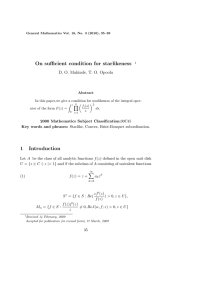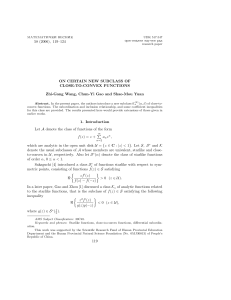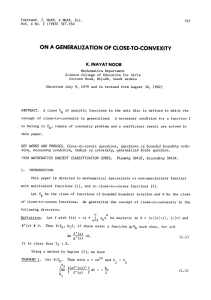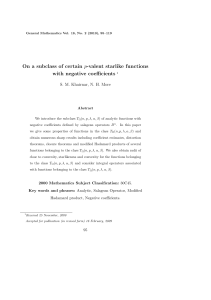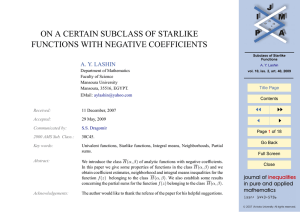BAZILEVI(
advertisement
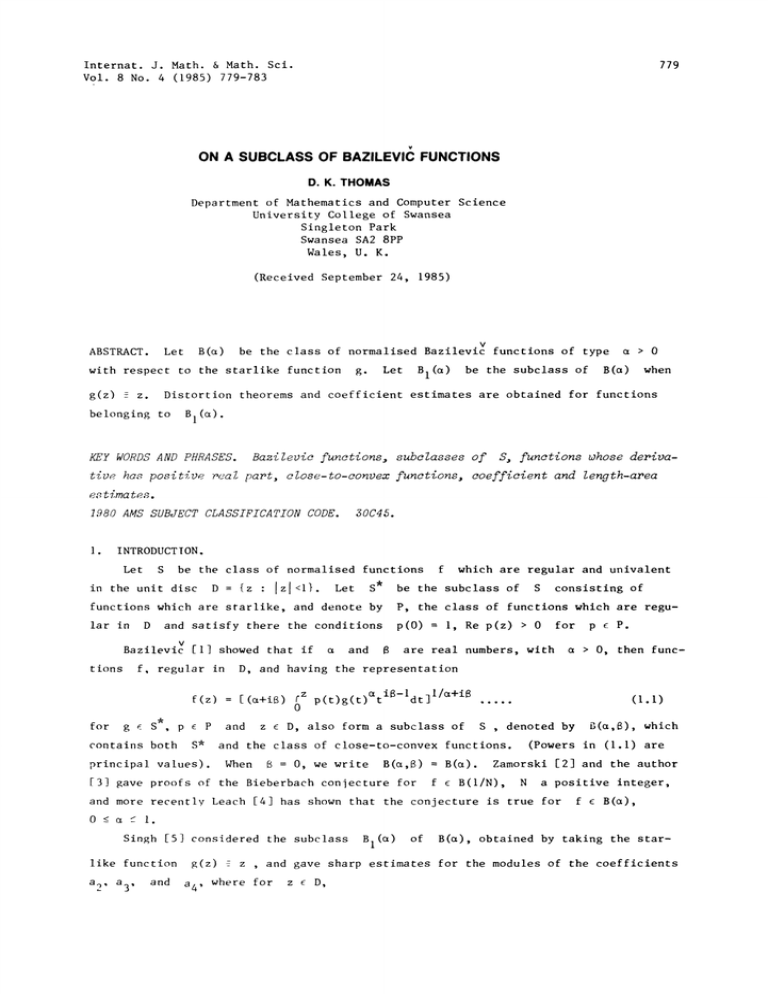
Internat. J. Math. & Math. Sci.
Vol. 8 No. 4 (1985) 779-783
779
ON A SUBCLASS OF
BAZILEVI( FUNCTIONS
D. K. THOMAS
Department of Mathematics and Computer Science
University College of Swansea
Singleton Park
Swansea SA2 8PP
Wales, U. K.
(Received September 24, 1985)
B()
Let
ABSTRACT.
v
be the class of normalised Bazilevic functions of type
with respect to the starlike function
g(z)
BI()
Let
g.
be the subclass of
0
B()
when
Distortion theorems and coefficient estimates are obtained for functions
z.
BI().
belonging to
KEY WORDS AND PHRASES. Bazievic functions, subclasses
tive has positive heal part, cose-to-convex functions,
of S, functions whose derivacoefficient and length-area
estimates.
1980 AMS SUBJECT CLASSIFICATION CODE.
I.
30C45.
INTRODUCTION.
Let
be the class of normalised functions
S
IzI<1}.
{z
D
in the unit disc
S*
Let
D
f, regular in
tions
f(z)
for
g
S*
contains both
P
p
S*
principal values).
a
S
be the subclass of
and satisfy there the conditions
v
Bazilevic [i] showed that if
which are regular and univalent
consisting of
P, the class of functions which are reguP.
0 for p
p(O)
I, Re p(z)
functions which are starlike, and denote by
lar in
f
are real numbers, with
and
rz
[(a+i)
and
0
p(t)g(t)
tiB-1 dt] I/a+i
D, also form a subclass of
z
(I.I)
S
(Powers in (I.I) are
and the class of close-to-convex functions.
When
O,
B
we write
B(a,B)
B(a).
B(a,), which
denoted by
Zamorski [2] and the author
f e B(I/N),
N
a positive integer,
and more recently Leach [4] has shown that the conjecture is true for
f
B(a),
I.
a
Si,gh [5] considered the subclass
like function
a 2, a
O, then func-
D, and having the representation
[3] gave proofs of the Bieberbach conjecture for
0
a >
3,
and
g(z)
z
BI()
of
B(), obtained by taking the
star-
and gave sharp estimates for the modules of the coefficients
a4, where for
z
D,
D.K. THOMAS
780
z
[z)
a z
n
n=2
We note that
BI(1)
Re f’(z)
for
0
n
S
is the subclass of
[1.z)
which consists of functions
f
for which
D [6].
z
sharp estimates for the coefficients
a
in (2)
n
BI(I/N)
f e
when
Bl(a)
f
In this paper, we shall obtain some distortion theorems for
N
and give
is a positive
integer.
2.
DISTORTION THEOREMS.
THEOREM I.
f e
(i)
Q2(r)
(ii)
and if
1/a
a-I
If(z)I
_<
Then with
z
re
i0
0 N r
I,
Ql(r) I/,
_<
a-< I,
I-
0
If
r
and be given by (1.2).
Bl(a)
Let
l-r <
a
Q2 (r)
ra-IQ
if ,(z)l
I+--
l+r
1-r
a
(r)
a e
1-a
1-e
r
a-I
l-r <
a
Q1 (r)
re-IQ 2(r)
f’(z)l
i+---{
a
l+r
I---
where
Ql(r)
a
Q2(r)
a
I
0
rOa-I (t_0)v- l+ do,
and
(o)do.
froa-1
0
Equality holds in all cases for the function
f(z)
0
where
PROOF.
(i)
or
z
Taking
D
and
Ip(z)I
and since
defined by
ta_l.l+tei)dt)i/a
(l_tei
fz
0
(2 I)
n.
8
equation
for
(a
f
_
0
P.
p
<_
l+r
z
1-a
-=
g(z)
and
f’(z)
in (I.I), it follows that
z
f(z)
l-a
f
satisfies the
(2.2)
p(z)
Thus
f(z)a
a f
z
ta-lp (t)dt,
0
for
z e D
[7], we have
at once
If(z)I
<
Ql(r) I/a.
Re p(z) > 0
To obtain the left-hand inequality in (i), we observe that, since
for
z
D,
Re p(z) ->
1-r
r
dz
Now let
Zl,
[Zll
r
[5],
and so from (2.2)
]a
>_ ar
a-
be chosen so that
l-r
(2.3)
(]-$r)
[f(zl)a[
-<
[f(z)a[
for all
z
with
[z[
r.
v
781
SUBCLASS OF BAZILEVIC FUNCTIONS
w
f(zl)a
fl(z )(
w
Then, writing
it follows that the line segment
D.
L
Let
from
0
w
to
be the pre-image of
%
then
The proof follows at once from (2.2) and (i) on noting that for
p
P,
lies entirely in the image of
by (2.3) we have
dw
[dzl
If(zl)la fxldwl fL ]zl
(1.1.1)d
fr pa-1
a
0
Q2(r),
p
which is the left-hand inequality in (i).
(ii)
1-r
1+r [7].
1+-’-’- lp(z)l
Equality is attained in (i) for
and in (ii) for
f0
f
when
o
0
and for
a e 1.
when
We remark that as
0, the results of Theorem
should in some way correspond
(univalent) functions [7].
to the classical distortion theorems for regular starlike
The following shows that the bounds in Theorem
0
tortion theorems as
THEOREM 2.
are asymptotic to the classical dis-
Let
Q1(r)
(i)
Ql(r)
Q2(r)
and
I.
be defined as in Theorem
Then for
0
r @
I,
as
(ii)
(iii)
’2 r
I/a
r
(l_r)
i/a
r
(l-r)
2
I.
Q2(r)
Ql(r)
2’
PROOF.
QI(r)I/
(
fr
0
p
-I
I/a
11__+_ )do
l_2ar-alog (l_r)) I/
r
r (l+2ar
-
re
a- O,
As
We prove (i), since (ii) and (iii) are similar.
fr
0
i_ do
-21og(l-r)
r
(l-r)
f(z)
Suppose that
COROLLARY.
lwl
Let
PROOF.
Let
L
lwl
w
Q2(1)
for
If(z)
L
as
for
at least once
a
then
as
0.
a
f(D)
be a point on the boundary of
e n D.
z e
D
z
I/a
denote the straight line from
sects
3.
O, and
a
w
0
(i) gives
Izl
lw]
r, for each
Q2(r)
I/a
and so
0 (from Theorem 2 (ii)).
A COEFFICIENT THEOREM.
NOTATION.
nZ=O anZ
n
nZ--O BnZ
n
means
l=.l -< lnl
closest to the orgin.
its pre-mage in
L
and
w
to
Since the circle
Theorem
2
for
n
-> O.
0
r
[w[
D
Then
inter-
Q2(1)
l/a
D.K. THOMAS
782
Let
THEOREM 3.
f
BI(I/N)
E
Suppose also that for
N
with
fo
fo(Z),
()N (N) (log
f(z)
(i)
(ii)
PROOF
(2.1).
is given by
Yn
z
+ n=2
as
n
Yn z
n
Then
n)
N-I
.
lenl -< IBnl
We first note that if
(i)
(1.2).
D,
z
fo(Z)
where
a positive integer, and be given by
Z
(n=l
enZ
then for
1,2
m
8 n z n)m
(nZ-I
To see this, let
anzn) m nZ=O An(m) z n
(n=IZ
(nZ=O 8n zn)m
and
Bn(m)
nZ=O
z
so that
A(k)
n
A(k_l) a n-
=I
We now use induction on
IA(1)I
2
n
n
1,2
k
1,2
A(j+I)
n
and
,j.
(I)
’IA(k)
n
n ->
Then [or
<
1,2,...
n
n
Z__I
-< B "k’(
n
IA(k)
n
Suppose now that
n
IA (j) II an_
I
n
B
Bn
B(k_l)
=I
to show that for
k
lanl
D
n
B(k)
n
B
(j)
B n-
n
B
(j+l)
n
Thus (i) now follows at once, since from (22) we can write
f(z)
where
+
p(z)
pk z
kE__l
k
z[l+
When
2
Pk zk
kZ__l
z
N
k +I/N
[pk[
and since
f(z)
(ii)
I+
z
[7] we have
k
< 2
]N
k
k+[/N
n
z[ i+ 2
f0 (z)
I/N, (2.1) gives
e
f0(z)
+
z
o(N) (.)’ (nl n+l/N
nE__2 Yn z
n
n
I n$1/N ]N
z
z
n
Now trivially,
n
n
(nE--1
n
4-)
<<
n
E
n/l IN
<<
(nil
Write these three series as
Z
n=
Then
n
C(9)z
n
n=
n
D()z
n
E
E ())z
n=
n
and
n
l
n=9
E(9)z
n
n
z
)
(n 0 _.__z
n+l
respectively.
Clearly for
< B (k)
n
for
v
SUBCLASS OF BAZILEVIC FUNCTIONS
Now a result of Littlewood [8, p. 193], states that if
783
is a flxed positive integer
and
(nE=O
n()
then
(log
n
n)-I
n
z
)
.
as n
n() z
n=0
n
Thus
E(V)
n
n-v
n=
C(V)zn
n
()
X(log
n
n)
Also
C
z
n=O
-I
D
()
(log
n
n
n)
=.
+
and so
-J
0 (j) (-I) n
(j)
()
n
as
n
and so
N
Yn
n
n
-I
v’--log
n
n
Thus
as
v$O (N
()v D () ()()(log n)N-I
n
as n
REFERENCES
v
I.
BAZILEVIC, I. E., On a case of integrability in quadratures of the Loewner-Kurafew
equation, Mat. Sb. 37 (79), 471-476. (Russian) MRIT, #356.
2.
ZAMORSKI, J., On Bazilevic schlicht functions, Ann. Polon. Math. 12 (1962), 83-90.
3.
THOMAS, D. K., On Bazilevic functions, Math. Z. 109 (1969), 344-348.
LEACH, R. J., The coefficient problem for Bazilevic functions, Houston J. Math. 6
(1980), 543-547.
4.
5.
6.
7.
8.
v
SINGH, R., On Bazilevic functions, Proc. Amer. Math. Soc. 38 (1973), 261-271.
MacGREGOR, T. H., Functions whose derivative has positive real part, Trans. Amer.
Math. Soc. 104 (1962), 532-537.
POMMERENKE, Ch, Univalent Functions, Vandenhoeck and Ruprecht, Gttingen, 1975.
LITTLEWOOD, J. E., Theory of functions, Oxford, 1944.






